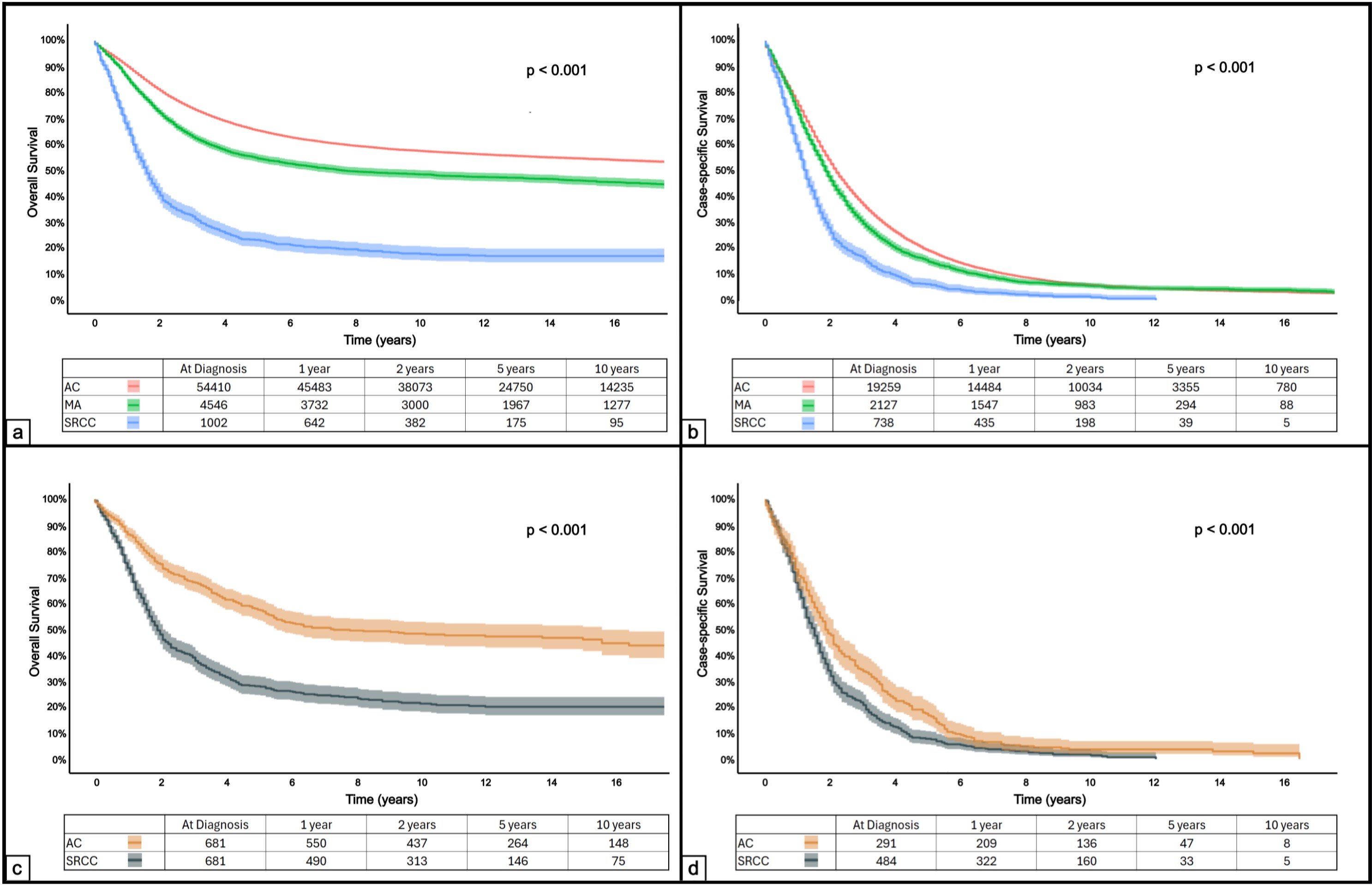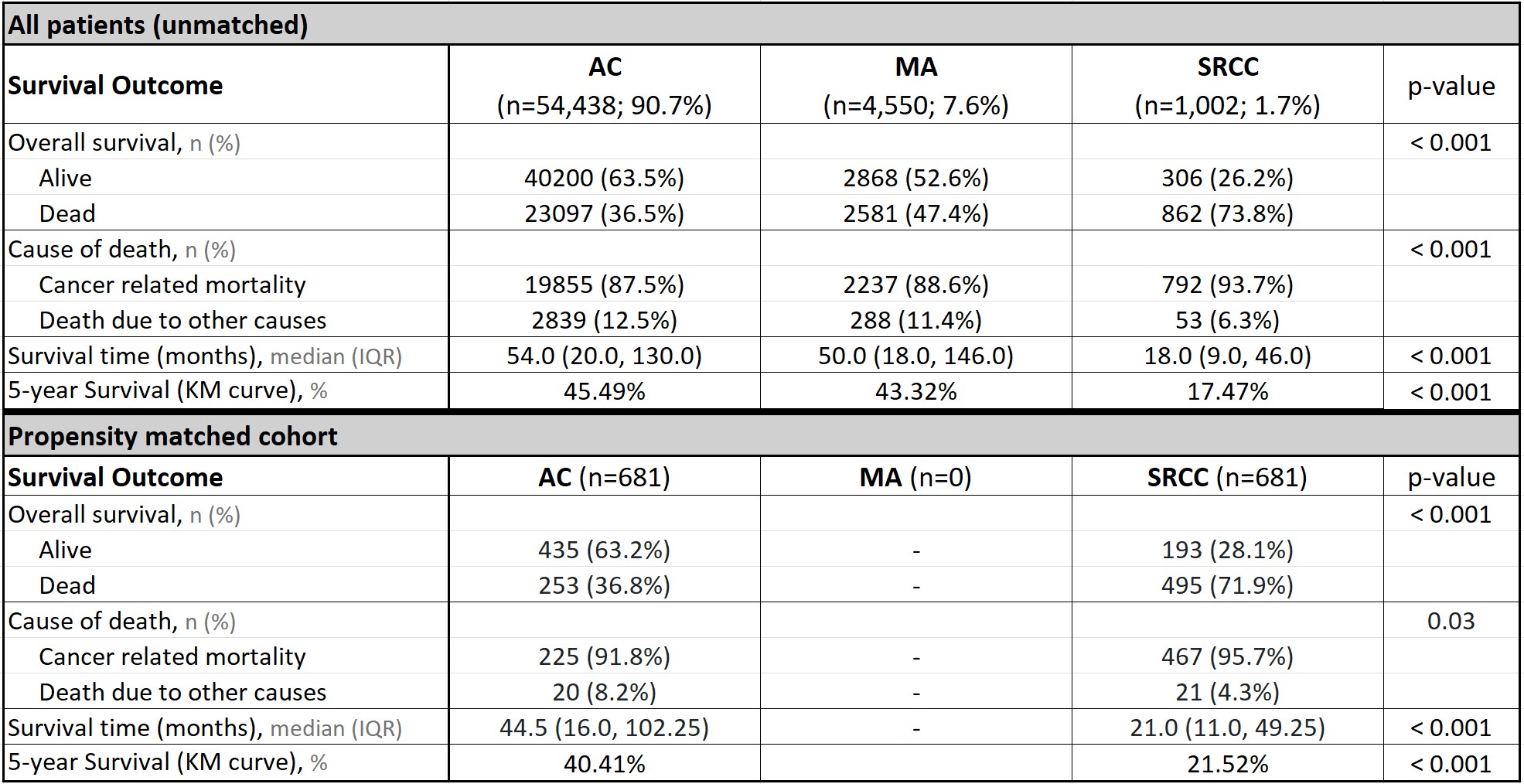Sunday Poster Session
Category: Colon
P0284 - Signet Ring Cell Carcinoma Has Poorer Outcomes in Young Adults Diagnosed With Colorectal Carcinoma: A SEER Database Study With Propensity Score Matching

Rohit Goyal, MD
Louisiana State University
Shreveport, LA
Presenting Author(s)
1Louisiana State University, Shreveport, LA; 2LSU Health, Shreveport, LA; 3Louisiana State University Health, Shreveport, LA; 4Case Western Reserve University / MetroHealth, Cleveland, OH; 5Texas Tech University Health Sciences Center, Odessa, TX; 6Emory University Hospital, Atlanta, GA
Introduction:
Colorectal cancer (CRC) remains the second leading cause of cancer-related mortality in the USA and is increasingly diagnosed in younger adults (aged < 50 years). CRC can have diverse histological presentations, most commonly adenocarcinoma (AC), signet ring cell carcinoma (SRCC), and mucinous adenocarcinoma (MA). Prior literature has shown that CRC with SRCC histology in older adults ( >50 years) has poor outcomes. CRC in young adults (< 50 years) is also associated with poorer survival outcomes, data on differences in clinical outcomes based on different histopathological subtypes are limited.
Methods:
We used the Surveillance, Epidemiology, and End Results (SEER) 17 database 2023 submission2, to identify patients aged 20-49 years, diagnosed with CRC between 2000 and 2021, with histology showing AC (8140, 8210-11, 8220-21, 8255, 8260-8263), MA (8480-8481), and SRCC (8490). Data on various baseline characteristics, tumor features, and outcomes were extracted using SEERStat software. Statistical analysis, including Pearson’s Chi-Square Test and Kruskal-Wallis Test to analyze categorical and continuous variables, respectively, was done using BlueSky Statistics Version 10.3.4. 1:1 propensity score matching was done between AC and SRCC patients to neutralize the confounding factors with a matching tolerance at 0.25, using R Studio (version 4.3.1). A significance level of p< 0.05 was applied.
Results:
We identified 59,991 patients aged 20-49 diagnosed with colorectal cancer, with histology showing AC (90.7%), MA (7.6%), and SRCC (1.7%). Propensity matching generated cohorts of 688 patients with AC and SRCC. Survival outcomes were significantly poor for SRCC patients, including overall survival (26.2% in unmatched and 28.1% in matched cohort), cancer-related mortality (93.7% in unmatched and 95.7% in matched cohort), median survival time (18 months in unmatched and 21 months in matched cohort), and 5-year mortality rate (82.5% in unmatched and 78.5% in matched cohort), as shown in Table 1. Results of the KM analysis done for the OS and CSS for both unmatched and propensity-matched cohorts are shown in Figure 1.
Discussion:
Our study concludes that patients with SRCC histology patterns have significantly poorer outcomes than other most common histology patterns. These outcomes highlight the necessity for customized treatment approaches, especially for younger patients dealing with less advantageous subtypes. 
Figure: Table 1: Clinical outcomes (unmatched and propensity-matched) in patients with early-onset colorectal cancer based on different histological subtypes. 
Figure: Figure 1: Kaplan-Meier curve (unmatched and propensity-matched) to show overall survival in young adults with colorectal cancer based on different histological subtypes. (a) Overall survival in the unmatched cohorts; (b) Case-specific survival in the unmatched cohorts; (c) Overall survival in the propensity-matched cohorts; (d) Case-specific survival in the propensity-matched cohorts.
Disclosures:
Rohit Goyal indicated no relevant financial relationships.
Karan Sachdeva indicated no relevant financial relationships.
Shruti Jain indicated no relevant financial relationships.
Rishi Chowdhary indicated no relevant financial relationships.
Anjul Verma indicated no relevant financial relationships.
Lovekirat Dhaliwal indicated no relevant financial relationships.
Sudha Pandit: Medtronic – Product feedback.
Rohit Goyal, MD1, Karan Sachdeva, MD2, Shruti Jain, MBBS3, Rishi Chowdhary, MD4, Anjul Verma, MD5, Lovekirat Dhaliwal, MD6, Sudha Pandit, MD1. P0284 - Signet Ring Cell Carcinoma Has Poorer Outcomes in Young Adults Diagnosed With Colorectal Carcinoma: A SEER Database Study With Propensity Score Matching, ACG 2025 Annual Scientific Meeting Abstracts. Phoenix, AZ: American College of Gastroenterology.
